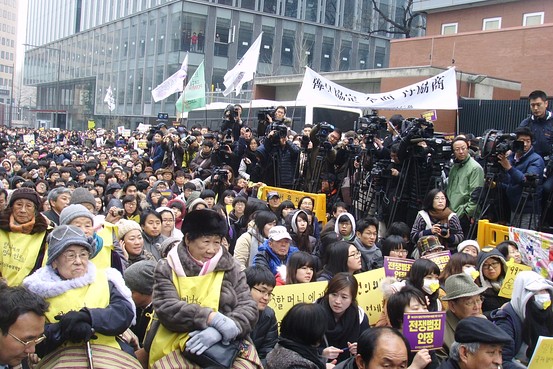KOREA: Tears, Gratitude and Anger Mark the 1,000th Protest


It was never meant to last 20 years.
In January 1992, a group of Korean women who were forced into sexual slavery by the Japanese military during World War II staged a protest outside the Japanese embassy in Seoul. They timed the protest to a visit by Japan's then-Prime Minister Kiichi Miyazawa. They became known as the “comfort women” and their weekly demonstration became known as the “Wednesday Protest.”
Today, with a crowd of about 3,000 joining in, the comfort women staged their 1,000th protest in front of the embassy.
Five former comfort women attended, sitting in chairs and covered in blankets. They wore a yellow vest with the sign that says “Honor & Human Rights to Halmeoni (Grandmothers).” The oldest of them, Kim Soon-ok, 90, used sign language to answer reporters' questions.
Kim Bok-dong, 88, went up to the stage and called for more action by the South Korean government as well as the Japanese government.
“I want President Lee to urge Japan to apologize for the past sins and make compensation,” she said to cheers from the crowd. “The Japanese Ambassador should make a formal apology as quickly as possible before we all die.”
During the past 20 years, many comfort women died. Today, only 63 are alive. The South Korean government since 1992 has registered 234 comfort women. During the war, an estimated 200,000 Korean women were forced to work in Japanese military brothels.
For more than two hours, the women and their supporters sang, clapped and listened to speeches. The five women also dabbed at their eyes from time to time. A few Japanese civic groups attended the event.
The highlight came midway through when a bronze sculpture was unveiled as a tribute to the comfort women. The statue is of a young girl in a hanbok, or traditional Korean dress, sitting on a chair. It was placed permanently on a sidewalk across the street from the embassy.
Cho Byung-jae, spokesman of the Ministry of Foreign Affairs, said Tuesday that the Japanese government complained about the monument.
On Wednesday, Japan's Chief Cabinet Secretary Osamu Fujimura said in Tokyo, “It is very regrettable that they went ahead with constructing the comfort woman statue.” He said they will make a formal request to Seoul remove it.
As for the complaints that the South Korean government is not doing enough to help these victims, Mr. Cho said, “It is indefensible that the government hasn't still resolved the problem while the protest reaches its 1000th.”
Later Wendesday, the Foreign ministry said it rejected Japanese government's complaint to remove the statue.
“The statue reflects the desperation by the victims who have been asking Japan to resolve the issue and seeking to recover their honor through 1,000 peaceful protests,” the ministry said in a statement.
In August, South Korea's Constitutional Court ruled that it is unconstitutional for the government to not actively seek to resolve the reparation issue of the comfort women. Mr. Cho said the foreign ministry contacted Tokyo to request a formal diplomatic discussion about the issue but didn't get a response.
As the event wound down, the comfort women said they will return next Wednesday – when there are likely to be fewer cameras – for the 1,001st protest.
PeaceWomen.org is a project of the Women's International League of Peace and Freedom, United Nations Office.
Fair Use Notice: This page contains copyrighted material the use of which has not been specifically authorized by the copyright owner.
PeaceWomen.org distributes this material without profit to those who have expressed a prior interest in receiving the included information for research and educational purposes.
We believe this constitutes a fair use of any such copyrighted material as provided for in 17 U.S.C § 107.
